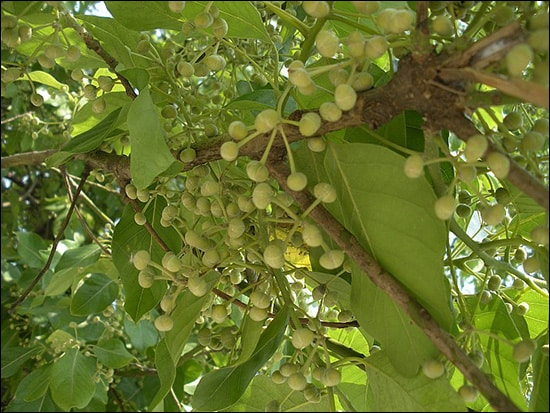Medasaka / Common Tallow Laurifolia (Litsea Glutinosa)- Ayurvedic Properties, Effects On Doshas & Dosage
Description
Ayurvedic medicines are the ancient system of medicines that is natural and is prepared with total purity and with 100% natural ingredients. These are not made with chemicals, so don’t show any kind of side-effects if used under the guidance of an experienced Ayurvedic practitioner. Ayurveda science gives longevity to life with proper health and disease-free life. Allopathic medicines only follow the symptoms of this disease but Ayurveda gives proper treatment by healing the root cause of the disease and gives us the knowledge of how we can prevent the disease by not undergoing surgeries and other life-risking procedures. The oldest known textbooks of Ayurveda are known by the name Charak Samhita, Sushruta Samhita, Ashtang Hridaya and many more. These books help physicians to gain knowledge about the disease, its causative factors, and its management in a holy manner.

General Information
Medasaka is the tree whose botanical name is Litsea glutinosa and belongs to the family of Lauraceae. This plant is found globally in different countries from India to Australia. This is found at an elevation of 4500 feet from sea level. This herb is widely known under different names in Sanskrit it is named Maida lakdi, in Punjabi – maidasak, in Bengali – Kukurchite, in Tamil – Meidalakavi, in Telugu it is Meida. This herb is very helpful in fungal diseases, controls cholesterol levels, keeps the digestive system healthy, chronic cough, and various vata-related disorders.
Special Note About This Plant
- Medasak is not described in old Nighantu but this is a very useful medicine for many diseases.
- Dr. Kalipad Vishwas has written in Bhartiya vanaushadhi, due to the resemblance of its name it is categorised under the ashtavarg in meda herb’s place but that one is a rhizome herb and this medasak is a tree and the properties of these both plants are different.
- This herb is known to pacify the Kapha and vata dosha.
- Its flowers bloom in the months of June and July and in September and October fruits appear on this tree.
- Its bark consists of Laurotetanine , actinodaphnine, norboldine, quercetin etc.
Ancient Verse
Shloka
मेदासकः सदापर्णः गन्धपर्णश्च स स्मृता:।
मध्यमाकृतिवृक्षाश्च लघुः स्निग्ध: कटुस्तिक्ताः कषायकः।
उष्णो वातकफौहन्ति शोथशूलविनाशनः।
दीपनः स्तम्भनाश्चैव सर्ववातविकारनुत्।।
अग्निमान्द्येऽतिसारे च रक्तस्रावे च युज्यते।
Reference – Dravyaguna
Interpretation of Shloka – Medasaka, sadaparn, gandhparn, are the synonyms, this is a medium-sized tree, is light in digestion, moisturises the body, bitter, pungent, astringent in taste, and is hot in potency so helps to pacify the vata and kapha dosha. It helps in inflammation, and pain, acts as an appetiser, and is used to stop the overflowing of urine and loose motions, so is very helpful in all Vataj conditions.
Systemic Classification
- Botanical Name – Litsea glutinosa
- Family – Lauraceae
- Genus – Litsea
- Species – L. glutinosa
Synonyms
- Gandhaparna – has aromatic leaves
- Sadaparna – leaves are always green and lustrous in texture
- Medakavi
Habitat
- It is a deciduous and semi-evergreen shrub or tree. It grows up to 25 m in height and about 1.5 m in girth with a clean bole. Its outer surface is brown and branchlets are somewhat slender.
- Leaves are glabrous, alternate, elliptical to oblong-elliptical, these are about 3.5 cm long and 1.5 cm in breadth.
- It has small yellowish flowers, stamens are in 8-15 in number.
- Its flowers bloom in the month of June and July and these are small in size, in September and October fruits appear on this tree.
- Fruits are round and resemble the size of a pea and are of the colour black or purple.
- There is small hairy growth on the branches, leaves, and flower stems.
Ayurvedic Properties
- Rasa (Taste) – Katu (Pungent), Tikta (Bitter), Kashaya (Astringent)
- Guna (Quality) – Snigadh (Moist), Laghu (light)
- Veerya (Potency) – Ushna (Hot)
- Vipaka (Post digestive effect) – Katu (Pungent)
- Karma (Action) – Balances the Vata dosha
- Projyang (Part used) – Bark is used
Effects On Doshas
- It balances the Vata dosha and reduces the vitiation of Vata dosha.
- Its bark and the extracted oil of this plant are anti-inflammatory and are used as proper analgesia.
Practical Uses
- This shrub is used in kapha and vata-related diseases.
- Its external application can reduce the inflammation of various diseases like rheumatoid arthritis, osteoarthritis, etc.
- This herb is used internally as srotoshodhak, so gives beneficial results in cervical spondylosis, gout, epileptic disorders, and various vata-related disorders.
- In the circulatory system, this shrub can relieve inflammation or various bleeding disorders.
- In old cough, this is beneficial as its Kapha shamak properties.
- This also eradicates the impotence and works on the reproductive system.
- Its oil is used as carminative and is vata pacifying in nature.
- Application of the paste of the bark of this plant can be used to get relief from the pain of fractures, arthritis, sprain, etc.
- Its oil can be anti-helminthic, or tapeworms by the dose of 5 to 8 drops.
- It also shows its beneficial properties in the management of diarrhoea and dysentery.
- Its decoction can also be given in intestinal catarrh.
- The seeds pounded together and applied on the boils.
Dosage
The powder of the bark can be used up to 1 to 3 grams in dose.
Ayurvedic Products
- Asthisandhanak Taila



